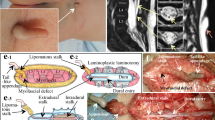Abstract
Introduction
Dorsal cutaneous appendages, sometimes referred to as “human tails,” are considered to be markers of underlying occult spinal dysraphism. Rarely, these tail-like structures can themselves be the cause of tethered cord syndrome. However, to date, a “bony human tail” causing tethered cord has not been reported in the literature. One such rare lesion is being reported.
Discussion
A 2-days-old female child was brought for neurosurgical consultation with a skin-covered bony protuberance in the lower back. Examination of the child did not reveal any neurological deficits. Plain radiographic and CT evaluation showed a dorsal bony protuberance arising from the posterior elements of L1 vertebra. MRI showed the cord to be displaced posteriorly and adherent to the undersurface of the bony tail through a lipoma. During surgery, the bony “tail” was excised, and the cord was untethered with excision of the lipoma, which was tethering the cord to the bony “tail.” When examined 1 year later, the child was developing normally without any focal neurological deficits.
Conclusions
This case is being reported for its rarity and to highlight the hitherto unreported occurrence of “bony human tail” causing tethered cord syndrome.






Similar content being viewed by others
References
Cai C, Shi O, Shen C (2011) Surgical treatment of a patient with human tail and multiple abnormalities of the spinal cord. Adv Orthop 2011:153797
Dao AH, Netsky MG (1984) Human tails and pseudotails. Hum Pathol 15(5):449–453
Donovan DJ, Pedersen RC (2005) Human tail with noncontiguous intraspinal lipoma and spinal cord tethering: case report and embryologic discussion. Pediatr Neurosurg 41:35–40
Humphreys RP (1996) Clinical evaluation of cutaneous lesions of the back: spinal signatures that do not go away. Clin Neurosurg 43:175–187
Lu FL, Wang PJ, Teng RJ et al (1998) The human tail. Pediatr Neurol 19:230–233
Matsumoto S, Yamamoto T, Okura K (1994) Human tail associated with lipomeningocele: case report. Neurol Med Chir (Tokyo) 34:44–47
Mohindra S (2007) The “human tail” causing tethered cervical cord. Spinal Cord 45:583–585
Muthukumar N (2004) The “human tail”: a rare case of tethered cord. Spine 29:E476–E478
Samura K, Morioka T, Hashiguchi K, Yoshida F, Miyagi Y, Yoshiura T, Satoshi O, Sasaki T (2009) Coexistence of a human tail and congenital dermal sinus associated with lumbosacral lipoma. Child’s Nerv Syst 25:137–141
Spiegelmann R, Schinder E, Mintz M et al (1985) The human tail: a benign stigma. Case report. J Neurosurg 63:461–462
Yamada S, Mandybur GT, Thompson JR (1996) Dorsal midline proboscis associated with diastematomyelia and tethered cord syndrome: case report. J Neurosurg 85:709–712
Author information
Authors and Affiliations
Corresponding author
Rights and permissions
About this article
Cite this article
Muthukumar, N. A bony human tail causing tethered cord syndrome: case report. Childs Nerv Syst 30, 703–707 (2014). https://doi.org/10.1007/s00381-013-2213-6
Received:
Accepted:
Published:
Issue Date:
DOI: https://doi.org/10.1007/s00381-013-2213-6




